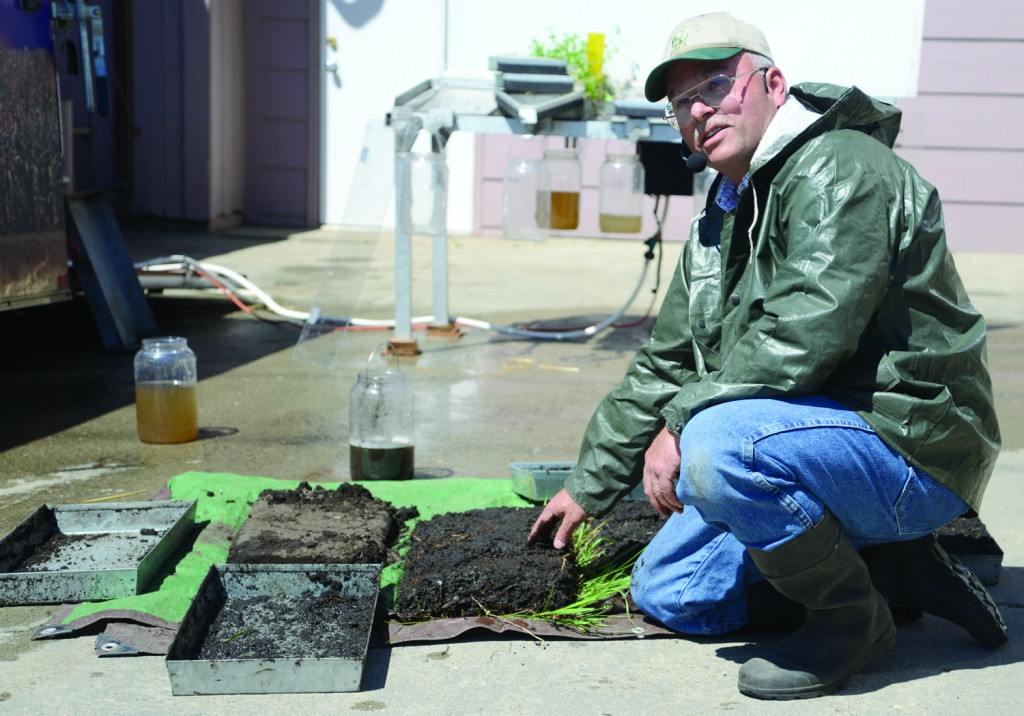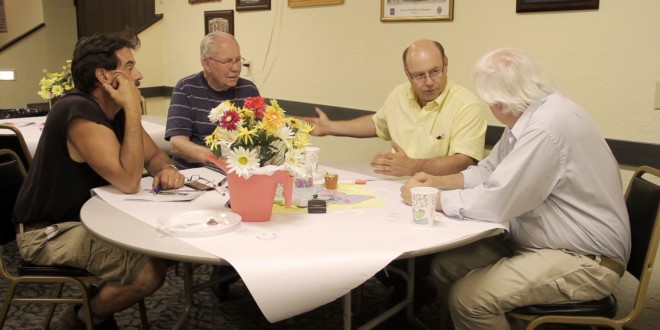The importance of water to the Webster area could be seen at the end of the Dakotafire Café event on May 29: When time ended for the official event, the conversations kept going.
About two dozen participants attended the event, which was held at the American Legion in Webster. The event was intended to get people talking about the stories presented in the May/June issue of Dakotafire on the topic of water. Many in Day County have a keen interest in water issues because of increasing lake levels that have put farmers, whose former fields are under water, at odds with sportsmen’s interests.

Jeff Hemenway shows how different ways of managing land results in the land absorbing water much differently. The grassland soil absorbed all the water, while most of the water ran off the tilled field. When the tray was flipped over, the soil was mostly dry. Photo by Amanda Fanger/Reporter & Farmer
Jeff Hemenway of the Natural Resources Conservation Service started by showing participants a rainfall simulation, which highlighted a clear difference in how land-use decisions affect how water moves on the landscape: On one end of the spectrum is a cool-season grass pasture, where almost all of the water infiltrates into the soil. On the other end of the spectrum is a tilled, black field, in which almost all of the rainfall runs off the surface, carrying many soil particles with it. The most dramatic moment of the simulation was when Hemenway turned the soil trays over. The tilled field was still dry dust 2 inches down, despite having the equivalent of 2 inches of rain put on it.

Laura Edwards discusses the wetting trend in the region: Although individual years will vary, we can expect more precipitation overall. Photo by Zeke Richter
Laura Edwards of SDSU Extension in Aberdeen showed precipitation data for the James River Valley region, pointing out that the region has seen a wetting trend over many decades. Edwards shared the results of a National Climate Assessment issued this spring that suggested that this wetting trend is likely to continue in the Dakotas, even as other parts of the country face persistent drought. “Increasing extremes in precipitation will continue to challenge agriculture,” Edwards said. “Folks should be managing, planning for, thinking about, not just agriculture but also communities for water supplies and water quality, because these extreme events are projected to become more likely.” The conversations that followed these presentations focused on three questions intended to define the problem in a new way, challenge assumptions in how we’re looking at it, and come up with bold solutions to address it in a way that results in a gain for everybody. Here are some interesting points from the Dakotafire Café conversations:
- Why do we use an abundant resource (water) mostly for recreation, while we bring in drinking water from the Missouri River?
- Sometimes we speak in terms of “they”—as in, “They just won’t do anything about it”—but we don’t define who “they” is. Who are “they”? If we don’t know, could it be that “they” is us?
- Finding a solution to increasing lake levels will require making sure that all stakeholders are involved in the decisions.
The event was sponsored by the Webster Area Development Corporation, Day County Champion Community, and Bella Vita. Check out this video summary of the event:
 Dakotafire Get your spark here.
Dakotafire Get your spark here.



